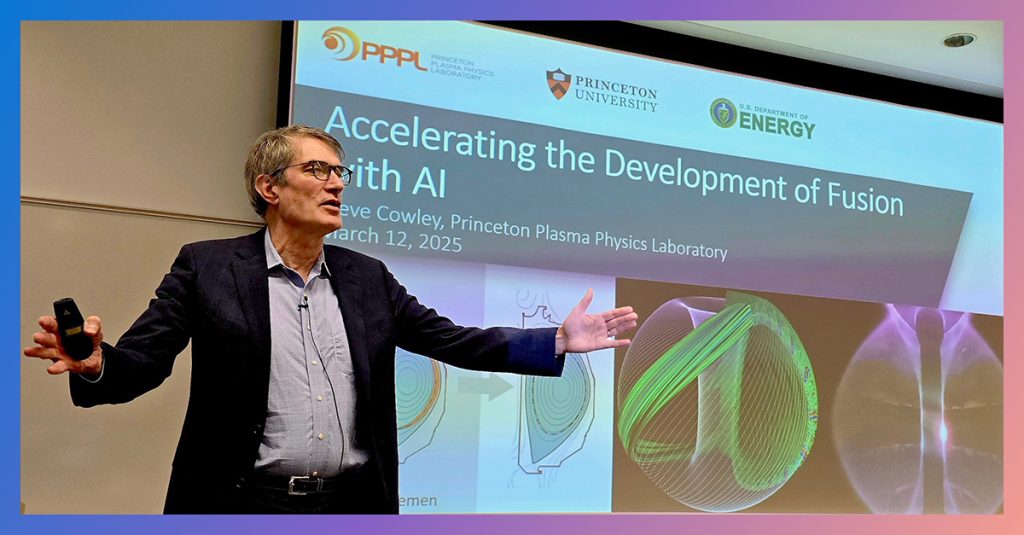
The pursuit of nuclear fusion as a limitless, clean energy source has long been one of humanity’s most ambitious scientific goals. Research labs and companies worldwide are working to replicate the fusion process that occurs at the sun’s core, where isotopes of hydrogen combine to form helium, releasing vast amounts of energy. While scalable fusion energy is still years away, researchers are now exploring how AI can help accelerate fusion research and bring this energy to the grid sooner.
In March 2025, Microsoft Research held its inaugural Fusion Summit, a landmark event that brought together distinguished speakers and panelists from within and outside Microsoft Research to explore this question.
Ashley Llorens, Corporate Vice President and Managing Director of Microsoft Research Accelerator, opened the Summit by outlining his vision for a self-reinforcing system that uses AI to drive sustainability. Steven Cowley, laboratory director of the U.S. Department of Energy’s Princeton Plasma Physics Laboratory (opens in new tab), professor at Princeton University, and former head of the UK Atomic Energy Authority, followed with a keynote explaining the intricate science and engineering behind fusion reactors. His message was clear: advancing fusion will require international collaboration and the combined power of AI and high-performance computing to model potential fusion reactor designs.
Applying AI to fusion research
North America’s largest fusion facility, DIII-D (opens in new tab), operated by General Atomics and owned by the US Department of Energy (DOE), provides a unique platform for developing and testing AI applications for fusion research, thanks to its pioneering data and digital twin platform.
Richard Buttery (opens in new tab) from DIII-D and Dave Humphreys (opens in new tab) from General Atomics demonstrated how the US DIII-D National Fusion Program (opens in new tab) is already applying AI to advance reactor design and operations, highlighting promising directions for future development. They provided examples of how to apply AI to active plasma control to avoid disruptive instabilities, using AI-controlled trajectories to avoid tearing modes, and implementing feedback control using machine learning-derived density limits for safer high-density operations.
One persistent challenge in reactor design involves building the interior “first wall,” which must withstand extreme heat and particle bombardment. Zulfi Alam, corporate vice president of Microsoft Quantum (opens in new tab), discussed the potential of using quantum computing in fusion, particularly for addressing material challenges like hydrogen diffusion in reactors.
He noted that silicon nitride shows promise as a barrier to hydrogen and vapor and explained the challenge of binding it to the reaction chamber. He emphasized the potential of quantum computing to improve material prediction and synthesis, enabling more efficient processes. He shared that his team is also investigating advanced silicon nitride materials to protect this critical component from neutron and alpha particle damage—an innovation that could make fusion commercially viable.
Microsoft research podcast
Collaborators: Silica in space with Richard Black and Dexter Greene
College freshman Dexter Greene and Microsoft research manager Richard Black discuss how technology that stores data in glass is supporting students as they expand earlier efforts to communicate what it means to be human to extraterrestrials.
Exploring AI’s broader impact on fusion engineering
Lightning talks from Microsoft Research labs addressed the central question of AI’s potential to accelerate fusion research and engineering. Speakers covered a wide range of applications—from using gaming AI for plasma control and robotics for remote maintenance to physics-informed AI for simulating materials and plasma behavior. Closing the session, Archie Manoharan, Microsoft’s director of nuclear engineering for Cloud Operations and Infrastructure, emphasized the need for a comprehensive energy strategy, one that incorporates renewables, efficiency improvements, storage solutions, and carbon-free sources like fusion.
The Summit culminated in a thought-provoking panel discussion moderated by Ade Famoti, featuring Archie Manoharan, Richard Buttery, Steven Cowley, and Chris Bishop, Microsoft Technical Fellow and director of Microsoft Research AI for Science. Their wide-ranging conversation explored the key challenges and opportunities shaping the field of fusion.
The panel highlighted several themes: the role of new regulatory frameworks that balance innovation with safety and public trust; the importance of materials discovery in developing durable fusion reactor walls; and the game-changing role AI could play in plasma optimization and surrogate modelling of fusion’s underlying physics.
They also examined the importance of global research collaboration, citing projects like the International Thermonuclear Experimental Reactor (opens in new tab) (ITER), the world’s largest experimental fusion device under construction in southern France, as testbeds for shared progress. One persistent challenge, however, is data scarcity. This prompted a discussion of using physics-informed neural networks as a potential approach to supplement limited experimental data.
Global collaboration and next steps
Microsoft is collaborating with ITER (opens in new tab) to help advance the technologies and infrastructure needed to achieve fusion ignition—the critical point where a self-sustaining fusion reaction begins, using Microsoft 365 Copilot, Azure OpenAI Service, Visual Studio, and GitHub (opens in new tab). Microsoft Research is now cooperating with ITER to identify where AI can be leveraged to model future experiments to optimize its design and operations.
Now Microsoft Research has signed a Memorandum of Understanding with the Princeton Plasma Physics Laboratory (PPPL) (opens in new tab) to foster collaboration through knowledge exchange, workshops, and joint research projects. This effort aims to address key challenges in fusion, materials, plasma control, digital twins, and experiment optimization. Together, Microsoft Research and PPPL will work to drive innovation and advances in these critical areas.
Fusion is a scientific challenge unlike any other and could be key to sustainable energy in the future. We’re excited about the role AI can play in helping make that vision a reality. To learn more, visit the Fusion Summit event page, or connect with us by email at FusionResearch@microsoft.com.

